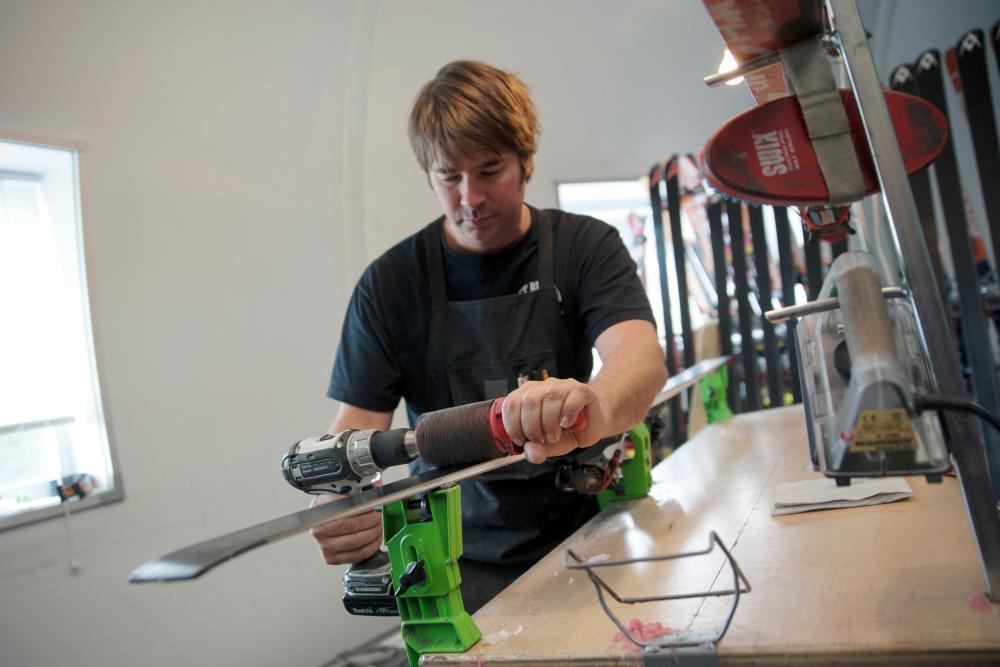All About That Base
12.19.2016 | Ski Racing Staff

Base repair needs immediate attention; how you tackle it depends on a few factors. The first step to resolving damage to your base is to take a good look at the ski. Hopefully, if you hit a rock, you were going straight and managed to confine the damage to the base material. If you also dinged your edge, you’ll need to spend some additional time filing and polishing to get things as smooth as possible.
The next step is to determine if it’s worth repairing yourself or going to a professional. If you’re near your local ski hill, take your skis to your local technician and have the damage fixed by a pro. Every good base repair should be stoneground to help boost the longevity of the overhaul, and a good technician can make quick work of filling and patching your skis, and stone-grinding them to help the work stick.
But if you’re traveling and in need of repair right away, there are several methods you can employ to help keep your skis on snow, even if you just need to get through one more day of a NASTAR series.
The first, and most common, approach to repairing base damage is a P-Tex candle. Cheap, easy to apply, and quick, a P-Tex candle belongs in every toolbox. With a lighter and just a little bit of practice, you can DIY a repair that will get you through in a pinch. These repairs, especially without stonegrinding, will fall out fairly quickly, but can do the trick for a day or two.

For DIY jobs, you’ll likely need a few special tools in your quiver
To increase the holding power of your P-Tex repair, be sure to clean out the damaged area — typically, bits of rock or dirt will be stuck in there. Cut loose any flaps of base material (or you can try Krazy Glue) and then light your P-Tex stick. Keep the candle as close to the ski as possible and move it to fill the entire area with a layer before coming back and continuing to fill. Build the repair up so that it’s higher than the surrounding base, and then let it cool. After five or so minutes use a Surform hand plane to gently flatten and level the repair.
Hand planes and patch templates help with more advanced repairs
A decent alternative to a P-Tex candle is J-B Kwik Weld (if you aren’t sure what this is, google it). This automotive mainstay is super easy to use, will hold forever, and can be applied in the field quickly to create a lasting repair. While J-B Weld can’t accept wax the way normal sintered racing base can, it does stand up well to being stoneground and never shrinks, abrades or falls out.
J-B Weld is an epoxy — you mix the contents of the two tubes 50/50 to create a goop that you can spread into the repair and then build up higher than the surrounding area. Find a paper plate or piece of cardboard as well as a drywall screw or Popsicle stick for mixing and application. Your local ski technician likely uses masking tape on the base to contain the J-B Weld to just the repair area. After applying with a screw or stick, you can use a metal scraper or razor blade to level the repair before the material sets up.
(ski tuning image)
J-B Weld makes quick work of repair jobs on the road and lasts seemingly forever
If the repair work needs to cover a larger area, you’ll need to employ some more drastic measures. Base patch travel kits are available from many retailers and offer you the ability to cleanly cut out (with a template) the affected area and glue in a pre-cut piece of base material. These repairs have great longevity but also require the highest level of skill to do properly. Stone-grinding as soon as possible is a must for a patch to work.
Base patches are expert-level repairs but yield the best results long-term
Once your repair, regardless of type, is complete, sand the area with some wet/dry 320-grit sandpaper. With the panic abated, you can now resume your normal daily tuning routine and get your skis ready to hit snow again. Remember to make an appointment to have your skis evaluated, re-repaired if necessary, and stoneground as soon as possible. They’ll need to be worked back into shape, but you’ll have made it through a NASTAR race series and are able to keep going without shelling out cash for new skis.